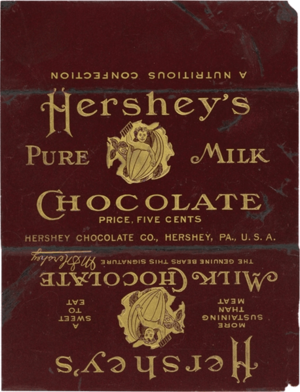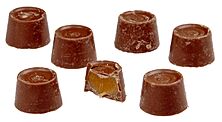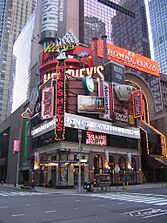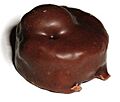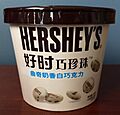The Hershey Company facts for kids
 |
|
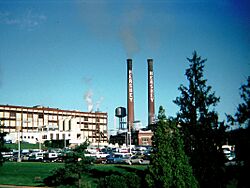
The original Hershey's factory in 1976
|
|
|
Trade name
|
Hershey's |
|---|---|
|
Formerly
|
|
| Public | |
| Traded as |
|
| ISIN | ISIN: [https://isin.toolforge.org/?language=en&isin=US4278661081 US4278661081] |
| Industry | Food processing |
| Predecessor | Lancaster Caramel Company |
| Founded | February 8, 1894 (as Hershey Chocolate Company) in Lancaster, Pennsylvania, U.S. |
| Founder | Milton S. Hershey |
| Headquarters |
19 E. Chocolate Avenue, Hershey, Pennsylvania
,
U.S.
|
|
Number of locations
|
19 plants (2022) |
|
Area served
|
Worldwide |
|
Key people
|
|
| Brands | List of The Hershey Company brands |
| Revenue | |
|
Operating income
|
|
| Total assets | |
| Total equity | |
| Owner | Hershey Trust Company (minority owner but owns the majority of the voting stock) |
|
Number of employees
|
16,620 (Full-time) (2021) |
The Hershey Company, often called just Hershey or Hershey's, is an American multinational confectionery company headquartered in Hershey, Pennsylvania, United States, which is also home to Hersheypark and Hershey's Chocolate World. The Hershey Company is one of the largest chocolate manufacturers in the world; it also manufactures baked products, such as cookies and cakes, and sells beverages like milkshakes, as well as other products. The Hershey Company was founded by Milton S. Hershey in 1894 as the Hershey Chocolate Company, originally established as a subsidiary of his Lancaster Caramel Company. The Hershey Trust Company owns a minority stake but retains a majority of the voting power within the company.
Hershey's chocolate is available in 60 countries. It has three large distribution centers with modern labor management systems. In addition, Hershey is a member of the World Cocoa Foundation. It is also associated with the Hersheypark Stadium and the Giant Center.
The Hershey Company has no affiliation to Hershey Creamery Company, though both companies were founded in Lancaster County, Pennsylvania, in the same year. The companies have had a tumultuous relationship marked by multiple legal battles over trademark issues. In the mid-1990s, the companies settled their most recent legal battles out of court, with Hershey Creamery Company agreeing to add a disclaimer to its ice cream products to note that it is not affiliated with the Hershey Company.
Contents
History
19th century

After an apprenticeship to a Lancaster confectioner in 1873, Milton S. Hershey opened a candy shop in Philadelphia. The venture failed, and so did a subsequent one in Chicago. After a third failed business attempt in New York City, Hershey returned to Pennsylvania, where he founded the Lancaster Caramel Company in 1883. The Hershey Chocolate Company was founded in 1894 as a subsidiary of Lancaster Caramel Company.
In 1896, Hershey built a milk-processing plant so he could create and refine a recipe for his milk chocolate candies. In 1899, he developed the Hershey process, which is less sensitive to milk quality than traditional methods. In 1900, he began manufacturing the Hershey's Milk Chocolate bar.
20th century
The use of fresh milk in caramels proved successful, and in 1900, after seeing chocolate-making machines for the first time at the 1893 World's Columbian Exposition in Chicago, Hershey sold his caramel company for $1,000,000 (equal to $35,176,000 today), and concentrated on chocolate. To people who questioned him, he said, "Caramels are just a fad, but chocolate is a permanent thing."
In 1903, Hershey began construction of a chocolate plant in his hometown of Derry Church, Pennsylvania, later known as Hershey, Pennsylvania. The town was an inexpensive place for the workers and their families to live, though the factory was built without windows, so that employees would not be distracted. To increase employee morale, Hershey provided leisure activities and created what would later become Hersheypark. The milk chocolate bars from this plant proved popular, and the company grew rapidly.
In 1907, he introduced a new candy: bite-sized, flat-bottomed, conical pieces of chocolate that he named Hershey's Kiss. At first, each was wrapped by hand in a square of aluminum foil. The introduction of machine wrapping in 1921 sped up the process and added a small paper ribbon to the top of the package, indicating that it was a genuine Hershey product. Today, over 70 million candies are produced daily.
Other products introduced included Mr. Goodbar (peanuts in milk chocolate) in 1925, Hershey's Syrup in 1926, semi-sweet chocolate chips (a mixture of milk and dark chocolate) in 1928, and the Krackel bar with crisped rice in 1938.
Reese's Peanut Butter Cups
Harry Burnett Reese invented Reese's Peanut Butter Cups after founding the H. B. Reese Candy Company in 1923. Reese died on May 16, 1956, in West Palm Beach, Florida, leaving the company to his six sons. On July 2, 1963, the H. B. Reese Candy Company merged with the Hershey Chocolate Corporation in a tax-free stock-for-stock merger. In 1969, only six years after the Reese/Hershey merger, Reese's Peanut Butter Cups became the Hershey Company's top seller. As of September 20, 2012, Reese's was the best-selling candy brand in the United States, with sales of $2.603 billion, and the fourth-best-selling brand globally, with sales of $2.679 billion. In 2024, after 61 years of stock splits, the original 666,316 shares of Hershey common stock received by the Reese family represent 16 million Hershey shares valued at more than $4.4 billion, paying annual cash dividends of $87.6 million.
Unionization
In the late 1930s, Hershey confronted labor unrest as a Congress of Industrial Organizations-backed union attempted to organize the factory workers. A failed sit-down strike in 1937 ended in violence; loyalist workers and local dairy farmers beat many of the strikers as they attempted to leave the plant. By 1940, an affiliate of the American Federation of Labor successfully organized Hershey's workers under the leadership of John Shearer, who became the first president of Local Chapter Number 464 of the Bakery, Confectionery, Tobacco Workers and Grain Millers' International Union. Local 464 now represents the Hershey workforce.
Atlantic City soap venture
From around 1938 to 1952, Milton Hershey tried to make toilet soap, which saw a big boom after the Great Depression as well as other hygiene-related items such as shampoo, toothpaste and perfume. Hershey took this opportunity to try to open a store on the Atlantic City Boardwalk, which sold cocoa butter scented toilet soap. The shop was a success for several decades, and the soap's production was sourced from Hershey Estates. Other soaps such as keystone soap, tar soap and shaving soap were also sold at the shop. Product distribution extended from New York City to Baltimore by 1953, when the shop closed down.
M&M's
Shortly before World War II, Bruce Murrie, son of long-time Hershey's president William F.R. Murrie, struck a deal with Forrest Mars to create hard sugar-coated chocolate that would be called M&M's (for Mars and Murrie). Murrie had a 20% interest in the product, which used Hershey chocolate during World War II rationing. In 1948, Mars bought out Murrie and became one of Hershey's main competitors.
Kit Kat and Rolo
In 1969, Hershey received a license from UK-based Rowntree's to manufacture and market Kit Kat and Rolo in the United States. After Hershey's competitor Nestlé acquired Rowntree's in 1988, it was still required to honor the agreement, and so Hershey continues to make and market the products in the U.S. The license would revert to Nestlé if Hershey were sold. This became a sticking point in Hershey's failed attempt to attract a serious buyer in 2002, and even Nestlé rejected Hershey's asking price, feeling that the economics would not work.
Cadbury
In 1988, Hershey's acquired the rights to manufacture and distribute many Cadbury-branded products in the United States (except gum and mints, which are part of Mondelēz International). In 2015, they sued a British importer to halt imports of British Cadbury chocolate, which reportedly angered consumers. A merger between Mondelēz and Hershey's was considered but abandoned in 2016 after Hershey's turned down a $23 billion cash-and-stock bid.
20th century sales and acquisitions
In 1977, Hershey acquired Y&S Candies (based in nearby Lancaster), makers of Twizzlers licorice candies, founded in 1845.
In 1986, Hershey's made a brief foray into cough drops when it acquired the Luden's cough drops brand. In 2001, the brand was sold to Pharmacia, now part of Pfizer, and Luden's later was acquired by Prestige Brands. Hershey's kept Luden's 5th Avenue bar.
In 1996, Hershey purchased the American operations of the Leaf Candy Company from Huhtamäki. In 1999, the Hershey Pasta Group was divested to several equity partners to form the New World Pasta company, which is now part of Ebro Foods.
21st century
On July 25, 2002, Hershey Trust Company announced that it sought to sell its controlling interest in the Hershey Foods Corporation. The value of Hershey stock rose 25% in a single day, with over 19 million shares traded. Over the following 55 days, criticism of the intended sale from media, the Pennsylvania Attorney General, the Hershey, and Dauphin County Orphans' Court senior judge, led the company to abandon its attempt to sell the company. Seven Hershey trustees who voted to sell Hershey Foods on September 17, 2002, for US$12.5 billion to the Wrigley Company, which is now part of Mars, Incorporated, were removed by Pennsylvania's Attorney and the Dauphin County Orphans' Court judge. Ten of the 17 trustees were forced to resign and four new members who lived locally were appointed. Former Pennsylvania Attorney General LeRoy S. Zimmerman became the new chairman of the reconstituted Milton Hershey School Trustees. Zimmerman publicly committed to having the Milton Hershey School Trust always maintain its ownership of the Hershey Company.
In December 2004, Hershey acquired the Mauna Loa Macadamia Nut Corp. from The Shansby Group.
In 2005, Krave Jerky was founded by Jon Sebastiani after he trained for a marathon and looked for a healthy source of energy. Alliance Consumer Growth, a private equity group, invested in Krave Jerky in 2012. Hershey's purchased the company in 2015 for $240 million. Hershey would later in 2020 sell Krave Jerky to Sonoma Brands, the food industry incubator founded by Sebastiani in 2016.
In July 2005, Hershey acquired the Berkeley, California-based boutique chocolate-maker Scharffen Berger Chocolate Maker. In November 2005, Hershey acquired Joseph Schmidt Confections, the San Francisco-based chocolatier, and in November 2006, Hershey acquired Dagoba Organic Chocolate, a boutique chocolate maker based in Ashland, Oregon.
In September 2006, ABC News reported that several Hershey chocolate products were reformulated to replace cocoa butter with vegetable oil as an emulsifier. According to the company, this change was made to reduce the costs of producing the products instead of raising their prices or decreasing the sizes. Some consumers complained that the taste was different, but the company stated that in the company-sponsored blind taste tests, about half of consumers preferred the new versions. As the new versions no longer met the Food and Drug Administration's official definition of "milk chocolate", the changed items were relabeled from stating they were "milk chocolate" and "made with chocolate" to "chocolate candy" and "chocolatey."
In December 2011, Hershey reached an agreement to acquire Brookside Foods Ltd., a privately held confectionery company based in Abbotsford, British Columbia.
In 2016, Hershey acquired barkTHINS, a New York-based chocolate snack foods company for $290 million.
An August 2016 attempt to sell Hershey to Mondelez International was abandoned following objections by the Hershey Trust.
In 2017, Hershey acquired Amplify Snack Brands, the Austin, Texas-based manufacturer of SkinnyPop in an all-cash transaction valued at approximately $1.6 billion. In September 2018, Hershey announced the purchase of Pirate Brands from B&G Foods for $420 million in an all-cash deal. These acquisitions marked Hershey's expansion into non-confectionery products.
In August 2019, Hershey announced it would purchase protein bar maker One Brands LLC for $397 million. In October 2019, Hershey announced a collaboration with Yuengling to produce a limited release collaboration beer titled Yuengling Hershey's Chocolate Porter, becoming Hershey's first licensed beer partnership. In June 2021, Hershey acquired Lily's for $425 million. In November 2021, Hershey announced plans to acquire Dot’s Homestyle Pretzels, and their co-packer, Pretzel INC for $1.2B.
In 2023, the company entered the field of plant-based chocolate concocted with dairy alternatives. The snacks are marketed as Plant Based Extra Creamy and Plant Based Reese's Peanut Butter Cups.
Brands
Hershey brands are mostly chocolate or candy-based, and the Hershey Company also manufactures gum. Its main markets are the U.S. and Canada.
Milton Hershey School (MHS)
Unable to have children of his own, Milton S. Hershey, founder of the Hershey Company, founded the Hershey Industrial School in 1909 for white orphaned boys. In 1918, three years after the death of his wife, Milton Hershey donated around $90 million to the boarding school in trust, as well as 40% of the Hershey Company's common stock. The school's initial purpose was to train young men in trades but eventually shifted to focus on preparation for college. The Hershey Trust Company has exercised voting rights for the school and has been a trustee since its founding.
Many of its designs resemble Hershey chocolate products, such as the Hershey Kisses street lights. Milton Hershey was involved in the school's operations until his death in 1945. The Hershey Industrial School was renamed the Milton Hershey School in 1951.
Manufacturing plants
The first plant outside Hershey opened on June 15, 1963, in Smiths Falls, Ontario, and the third opened on May 22, 1965, in Oakdale, California. In February and April 2007, Hershey's announced that the Smiths Falls and Oakdale plants would close in 2008, being replaced in part by a new facility in Monterrey, Mexico. The Oakdale factory closed on February 1, 2008. Hershey chocolate factory in São Roque, Brazil, was opened in August 2002. Hershey's Asia operations were largely supplied by their plant in Mandideep, India.
Hershey also has plants in Stuarts Draft, Virginia, Lancaster, Pennsylvania, Hazleton, Pennsylvania, Memphis, Tennessee, Robinson, Illinois, and Guadalajara, Mexico.
Visitors to Hershey can experience Hershey's Chocolate World visitors center and its simulated tour ride. Public tours were once operated in the Pennsylvania and California factories, which ended in Pennsylvania in 1973 as soon as Hershey's Chocolate World opened, and later in California following the September 11, 2001, attacks, due to security concerns.
On September 18, 2012, Hershey opened a new and expanded West Hershey plant. The plant was completed at a budget of $300 million.
On March 9, 2018, Hershey broke ground to expand its Kit Kat manufacturing facility in Hazle Township, Pennsylvania. The expansion project has a $60 million budget and is expected to create an additional 111 jobs at the facility.
On August 17, 2023, it was announced that Hershey repurchased their plant in Smiths Falls, Ontario for $53 million.
Product recalls
- In July 1998, a number of 100 g (3.5 oz) milk chocolate bars being sold for fundraising events were recalled because they may have contained traces of almonds not listed in the ingredients.
- In November 2006, the Smiths Falls production plant in Ontario temporarily shut down and several products were voluntarily recalled after concerns over Salmonella contamination possibly found in soy lecithin within their production line. It was believed that most of the products involved in the recall never made it to the retail level.
Decarbonization
In October 2022, the company's Scope 1 and 2 emissions were "48% lower than they were in 2018". Scope 3 emissions had gone down 18%.These reductions were achieved by investments in three solar farms.
Carbon footprint
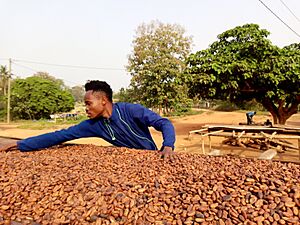
Within the confectionery industry, many essential ingredients are only able to grow in specific areas of the world. This makes them more susceptible to the negative impacts of climate change and increasing temperatures. Confectionery agriculture greatly impacts the environment. The emissions from the anaerobic decomposition of the cocoa pod husk contributes to the carbon footprint of agriculture. Producing cocoa using agroforestry method has negative effects that include the harmful composition of cocoa pod husks. However, different types of agricultural management have different levels of negative impacts on the environment. Even when using the improved methods of agriculture for cocoa, the transportation of the product reduces the benefits achieved from that method. Growing cocoa, specifically sugar confectionary products, is water intensive, resulting in water depletion. Additionally, packaging materials contribute to negative environmental effects.
In order to address these environmental concerns, Hershey Company made a commitment to environmental and climate change goals. The company's goals are in line with the principles of Environment, Social and Governance (ESG). Included in their commitment is an environmental policy called Our Shared Goodness Promise which provides direction for Hershey's decisions that ultimately affect the environment. One of its main goals is to reduce Scope 1 and Scope 2 GHGs by 50% and reduce Scope 3 GHGs by 25%. To help reach this goal, Hershey turned its focus towards energy efficiency policies. Every Hershey location has an "Energy Champion" to ensure energy goals are met. On top of energy efficiency, Hershey has also committed to improving their packaging. Implementing more sustainable packaging will help the company reach their Scope 3 GHGs goal. They have set a goal to lower packaging weight by 25 million pounds by 2030 to decrease the environmental impact of their materials. Previously, Hershey reached their goal of reducing packaging weight 5 years before their target year. Going one step further, Hershey committed to switch their plastic packaging over to sustainable materials that can be recycled by 2030 through elimination and redesign. Hershey is working with Ecom, Ghana's Nature Conservation Research Center, the Ghana Forestry Commission, and the Ghana Cocoa Board to work against deforestation. This collaboration will push Hershey towards reaching their Scope 3 GHG goal. They are putting their focus on suppliers that deal with the primary products that contribute to deforestation. If any of their suppliers do not comply with this No Deforestation goal, they will cut ties.
Philanthropy
Hershey has made large contributions to education. One of their most notable contributions was to the honors program at Elizabethtown College in Elizabethtown, Pennsylvania. The program was established in 1999 and is funded partially through the endowment.
In 2015, Hershey announced a commitment to the Clinton Global Initiative to help build a sustainable supply chain to support basic nutrition for children in Ghana.
Hershey's long-term focus on children and families has yielded long-standing partnerships with organizations such as Children's Miracle Network, Ronald McDonald House, and United Way (UW). In 2016, the company donated more than $486,200 to those organizations.
Perception outside the U.S.
The presence of butyric acid in Hershey's chocolate, due to the use of controlled lipolysis in the production process, results in a flavor unfamiliar to those accustomed to chocolate from other parts of the world. In the UK, this has often been compared to the smell and taste of vomit.
Gallery
-
A Reese's Peanut Butter Pumpkin split in half
-
PayDay Peanut Caramel Bar
-
Mini Almond Joy chocolate
-
Chinese Cookies 'n' Creme tub
Additional sources
- Our History | HERSHEY'S
- History | The Hotel Hershey
- Official Hershey's chocolate and candy site: https://www.hersheyland.com/home
See also
 In Spanish: Hershey's para niños
In Spanish: Hershey's para niños
- List of products manufactured by The Hershey Company
- List of food companies
- Pennsylvania chocolate workers' strike, 1937


